-a remarkable Table Clock. Erected on four spinning feet simulating woven wicker baskets such as those worn during a recreational stroll in the landscaped gardens of the Domaine de Trianon by the Souveraines or Powdered Ladies of Quality of Yesteryear, it has a rectangular base with slight projections and rounded sides. Darkened on all sides with a gilded bronze counter-background, it is adorned with a most refined openwork ornamental decoration. Set with molded listels, friezes with neo-classical motifs of posts, bezants braid reserves worked with a mesh inspired by the charming basketwork of the 18th century. This Treillage decoration, evocative of rediscovered rural pleasures, echoes within an oval medallion highlighted with a pearl a Pastoral Trophy: chiseled on an amati background, it unites, held by a ribbon knot, musical attributes with soft tones (musette, oboe, double-Flute) and playful attributes associated with gardening activities (shovel for soil, rose bud stalk). On its terrace decorated with delicately chiseled rose branches stands, haughty, looking to the right a vigorously modeled Eagle. Within its outstretched wings is nestled an opening sphere containing the movement of the clock. Two dart-shaped hands indicate the hours in Arabic numerals cut out and riveted to the globe surrounded by leafy stems of rose buds. Signed "Mottheau/ A Paris", this quality timepiece is similar in its general design to the famous clock known as "Aux Aiglons" (Versailles, Musée National des Châteaux de Versailles et de Trianon, Inv.T 50 C) executed jointly with a pair of Arms of Light (Lisbon, Musée Calouste Gulbenkian, Inv. 18 A/B) in 1787-1788 on models by Jean-Démosthène Dugourc (1749-1823), designer of the Garde-Meuble de la Couronne by Pierre-Philippe Thomire (1751-1843), eminent Bronzier, chaser-gilder of the last third of the 18th century for Marie-Antoinette, commissioner for her private apartments of the Petit Trianon of a piece of furniture (Queen's bedroom known as "Du Treillage" or "Des Epis" ) in perfect harmony with the Nature, both rustic and delightfully enchanting, of the surrounding landscaped Estate.
To discerningly decline the elegant hurdiness of composition, the feminine seductions of the basketwork decoration of its illustrious predecessor, our clock nevertheless stands out in terms of the adopted summit motif: for the "Two Eaglets" - emblems of the family of the Archduchess of Austria -, it substitutes the central figure of an Eagle - as found in particular in the "Cahier de six Pendules à l'usage des Fondeurs, Dessinées par Jean-François Forty (1721-178?)" (circa 1775-1794, Paris, INHA, Fonds Jacques Doucet, Cahier D, Pl. 4). Associated with the Venusian motif of the rose - emblematic flower of the Queen traditionally dedicated to Venus, goddess of Love), the imperious bird perpetuates the pleasures of romantic feeling. -an original Pair of Candelabras matching three light arms-On a tripod base and triangular plinth with curved sides adorned with the rustic decor adopted for the timepiece are riveted three sturdy goat's hooves. From their vigorous acanthus leafy jamb joined by a stepped ring, the Horns of Amalthea - an allusion to the wet-nurse of Zeus but also to the rural world aristocratically staged by Marie-Antoinette in the Hamlet of the Trianon Gardens - are magnificently displayed, forming light arms. Nervously chiseled, these, haloed at their flare with a smart corolla deliciously flowered with Roses, encase a quiver with arrow fletching, whose features give birth to Love. Embellished on its base with a pine cone, this attribute of sentimental vocation -, is embellished on its sheath worked with twisted fluting of undulating rose stems. Their arrangement gives these candelabras exalting the spring prodigality of Nature elegance and refinement. Respectful of the amiable theme as well as the innovative aesthetic advocated by the museum watch piece, this atypical Pair of Candelabra of which we do not know of any precedent is probably an original creation of the Maison Mottheau which, offered to its privileged clientele, in addition to "Fireplace Fittings, Chandeliers, light arms, wall lights, .." of "Old Genres" or executed on "Models of the Garde-Meuble and the National Palaces", sophisticated lighting pieces designed in close collaboration with the most renowned sculptors-ornamentalists of the time. A fine example of these "Grande Décoration" sets designed by prestigious Parisian Maisons de Bronzes d'Art et d'Ameublement from the second half of the 19th century, this Mantelpiece signed by Ernest Mottheau (1841-1905) illustrates, both by its undeniable formal elegance and by its great finesse of chiseling, the know-how and skills of an outstanding Establishment recognized for its models combining - without copying them - illustrious references and imaginative sensitivity.
---------
The Maison MOTTHEAU (1864-1912), in Paris - Coming from a modest family of Master quarrymen, Ernest-Antoine-Louis Mottheau (1841-1905), initiated very early into the profession of "worker-chaser" (1853-1857) founded in 1864 at 7, rue du Perche (Paris, 3rd arr.) his own Maison de Bronzes d'Art et d'Ameublement. Temporarily (1865-1878) associated under the company name "Bouhon et Mottheau" with Auguste-Matthieu Bouhon (1839-1890), Parisian Bronze Manufacturer renowned for "the perfection of work, the elegance and the unequaled originality" of his "Fireplaces and Fireplace Fittings" with which he distinguished himself at the Universal Exhibitions in Paris in 1867 and 1878, E. Mottheau "managed, thanks to persevering work, exceptional intelligence combined with scrupulous probity", to win his own letters of nobility by specializing (1880) in Bronzes of Art of Lighting. From then on, the Maison Mottheau never ceased to establish its reputation, to compete in excellence with outstanding Parisian Establishments (Bagueès, Collin, Denière, Lacarrière, Lemerle-Charpentier, Lerolle, Servant) and, in a decade to establish his reputation. Called to participate in the Committees and Jury of the Great Parisian Exhibitions (1886, 1887 and 1892), Ernest Mottheau will be awarded at the Universal Exhibition of 1889 for "his products, known and esteemed for their beauty and their industrial value" with a Gold Medal. In 1890, he moved his Establishment to 50, rue des Tournelles. The same year, a large insert written in the Annuaire-Almanach du Commerce, .. of Paris gives the measure of his social rise, of the scope of his House: "Mottheau Ernest/ Gold Medal at the Universal Exhibition of Paris 1889/ Bronzes of Art and Lighting/ Specialty of Lighting/ Chandeliers, Wall Lights, Arms, Torchères, etc. of All Styles/ Models of the Garde-Meuble and the National Palaces/ Crystal Fittings, Old Style..". In 1897, he added to his flourishing company the participation of his son, Eugène Mottheau who maintained, after the death (1905) of his father, "the exceptional situation acquired in the industrial and artistic world" by this emeritus Factory now "of the first order". The Grand Prix obtained at the Universal Exhibition in Paris in 1900 - notably for the exhibition of La Nature, a sculptural and audacious luminous torch designed for the House by the talented sculptor-ornamentalist Frédéric-Eugène Piat (1827-1903) - will crown the "cursus honorum" copy of Ernest Mottheau. Like his accessit to the title of Knight of the Legion of Honor (August 16, 1900), this high distinction "unanimously applauded" will salute the "career full of honor and work" of this "Founder-chaser" who had the privilege of supplying the crowned heads of Portugal and Denmark, as well as State Establishments located in Spain, Sweden and Turkey, with Art and Furniture Bronzes. ----------------
Bibliography: -Marie-Antoinette, Exhibition Catalogue, Paris, Galeries nationales du Grand Palais, June 15-30, 2008, Paris: RMN:2008, p. 283-284, no. 206 and 207;-Masterpieces from the Gulbenkian Museum in Lisbon. Royal Furniture and Objects of the 18th Century in France, Paris: RMN, 2000, p. 104, Cat. 26
-Annuaire-Almanach du Commerce, Firmin-Didot, 1870- 1908; Babelon Ernest, Art at the 1900 Universal Exhibition, Paris: 1912, p. 453;-Lamathière, Théophile de, Panthéon de la Légion d'Honneur, Paris: 1875-1910, Volume 19, pp. 181-182;-- Devaux, Yves, The Universe of Ornamental Bronzes and Cast Iron, 1850-1920, Paris: Pygmalion, 1978, p.282;-Marx, Roger, Decoration and Industries at the Universal Exhibition of 1900, Paris: 1901, p. 57.-Quantin, Albert, L'Exposition du Siècle, L'Art décoratif Français, Paris: 1901, p.101, illust..;-Les Salons de 1902: L'éclairement, in: Revue de l'Art ancien et moderne, dated January 10, 1902, p.419
-----------------------
Marks and Signatures: Dial signed: Mottheau/ Paris- On the plate of the Movement numbered "565", stamp of the Watchmaker "Vincenti/ Médaille d'argent/ 1855"
Materials: bronze chased and gilded to the mat; sheet metal or black enameled copper.
Dimensions: Pendulum: H.: 29 cm;-L.: 32 cm;-Pr.: 10 cm Candelabra: H.: 25 cm; L.: 10cm; Pr; : 10 cm
Remarkable Parisian work of the Maison Mottheau in the Louis XVI Marie-Antoinette style after a model by Pierre-Philippe Thomire. Last third of the 19th century, Circa 1890
Very Good Condition. Original gilding. Minor wear and tear.




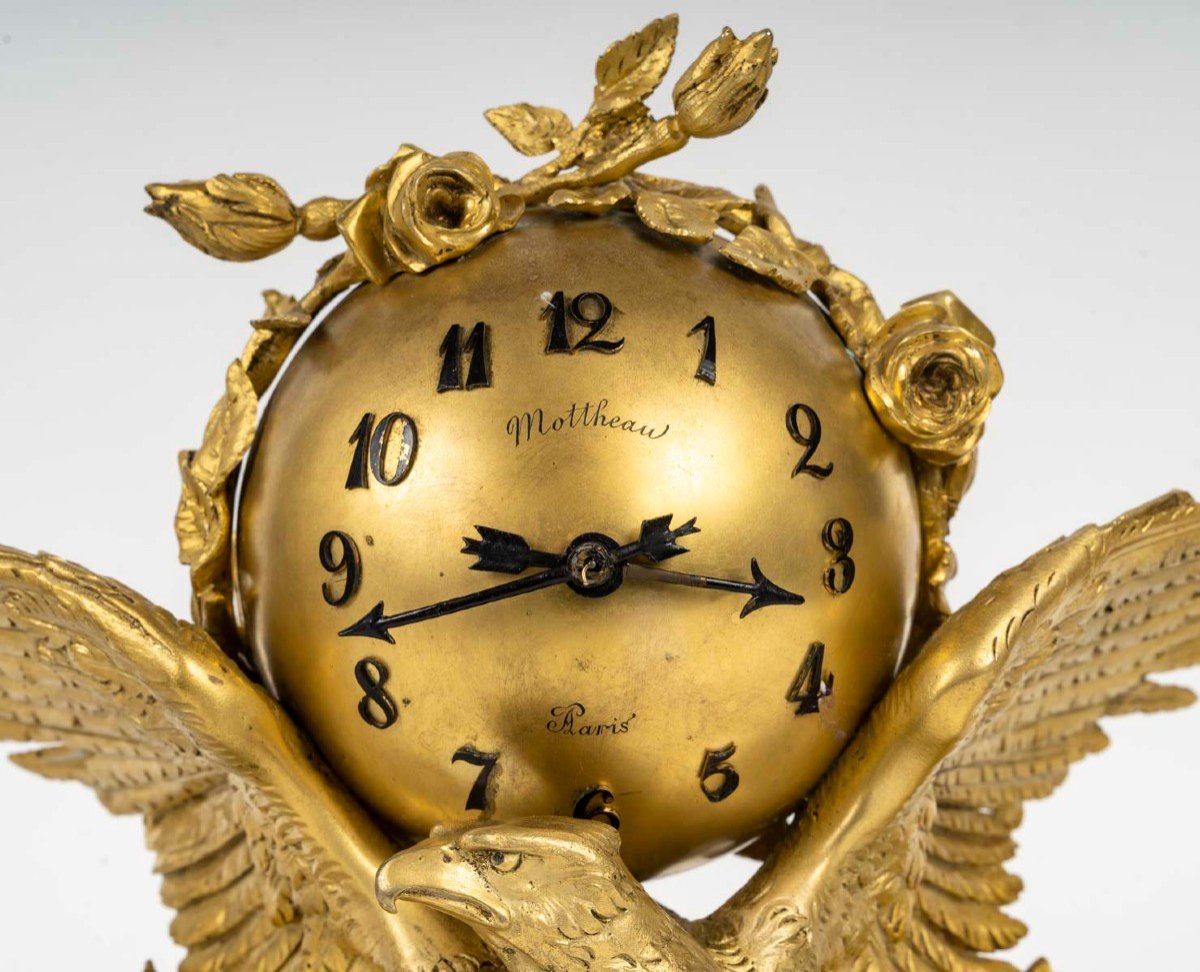

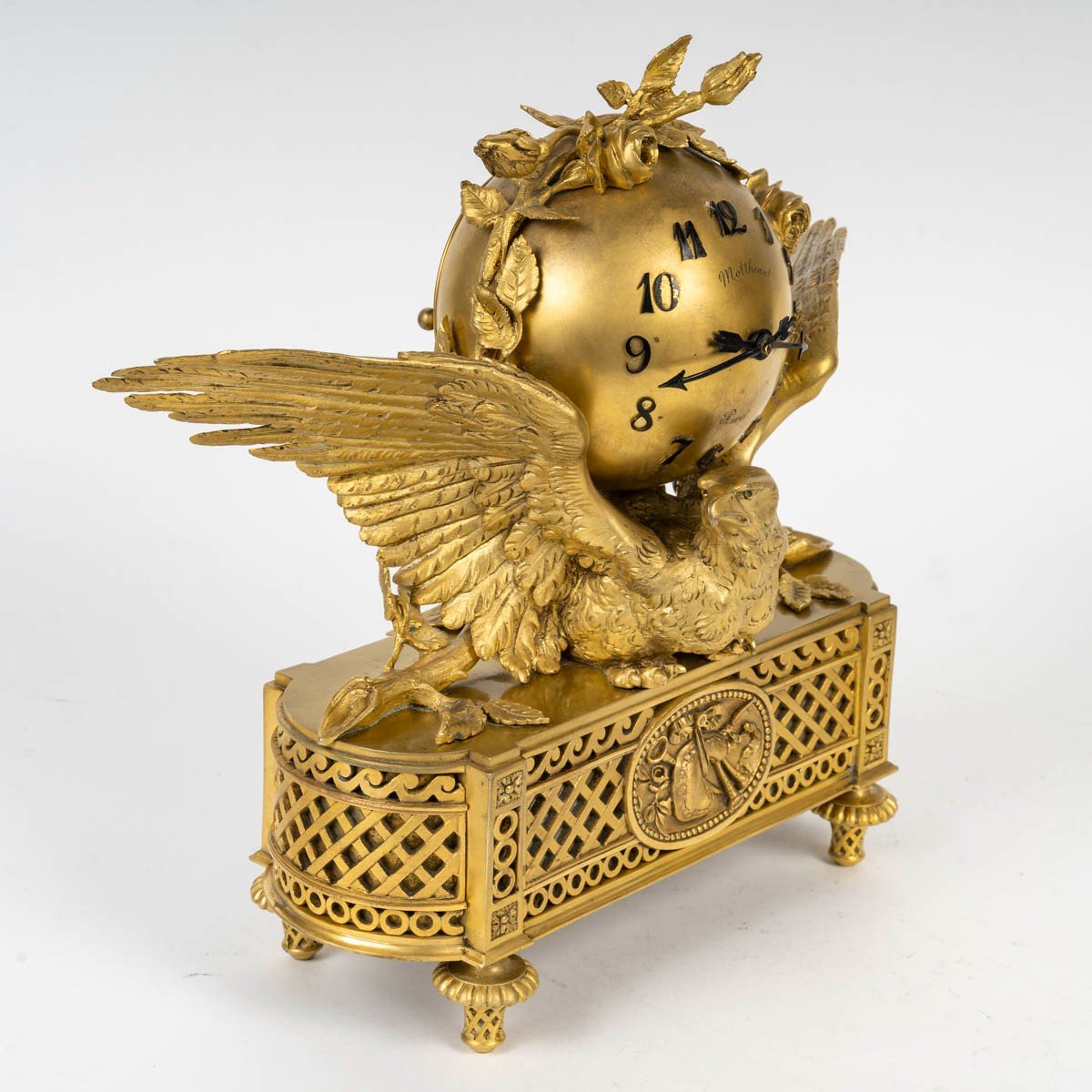


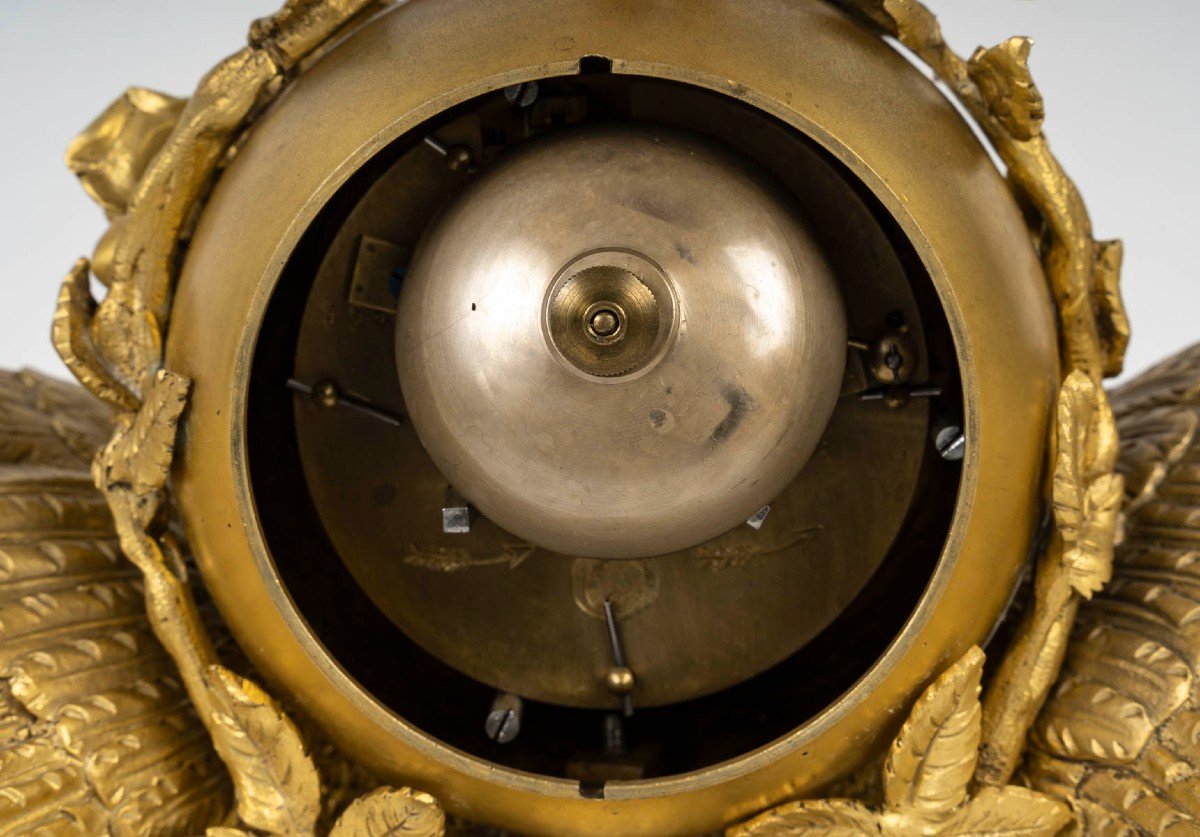
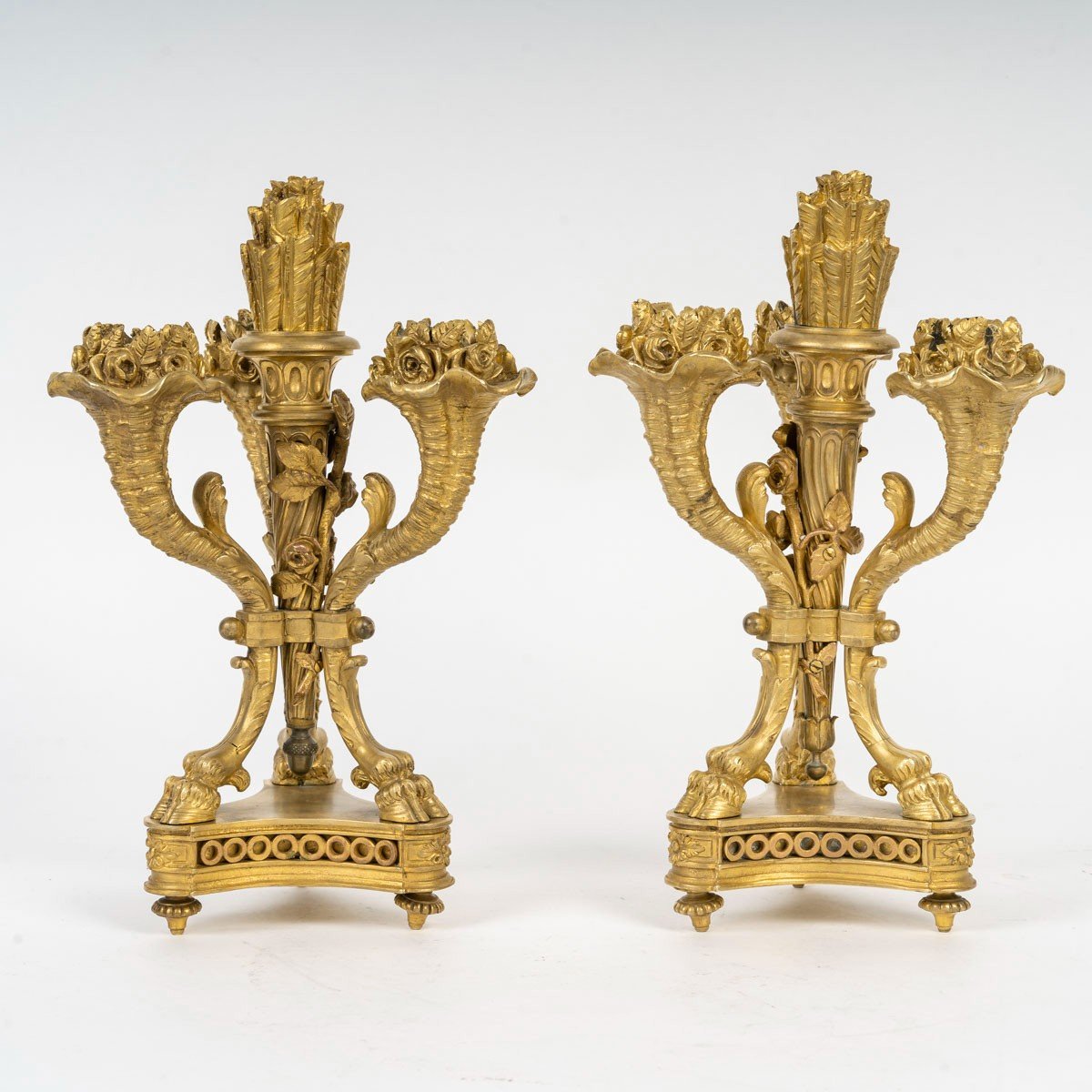

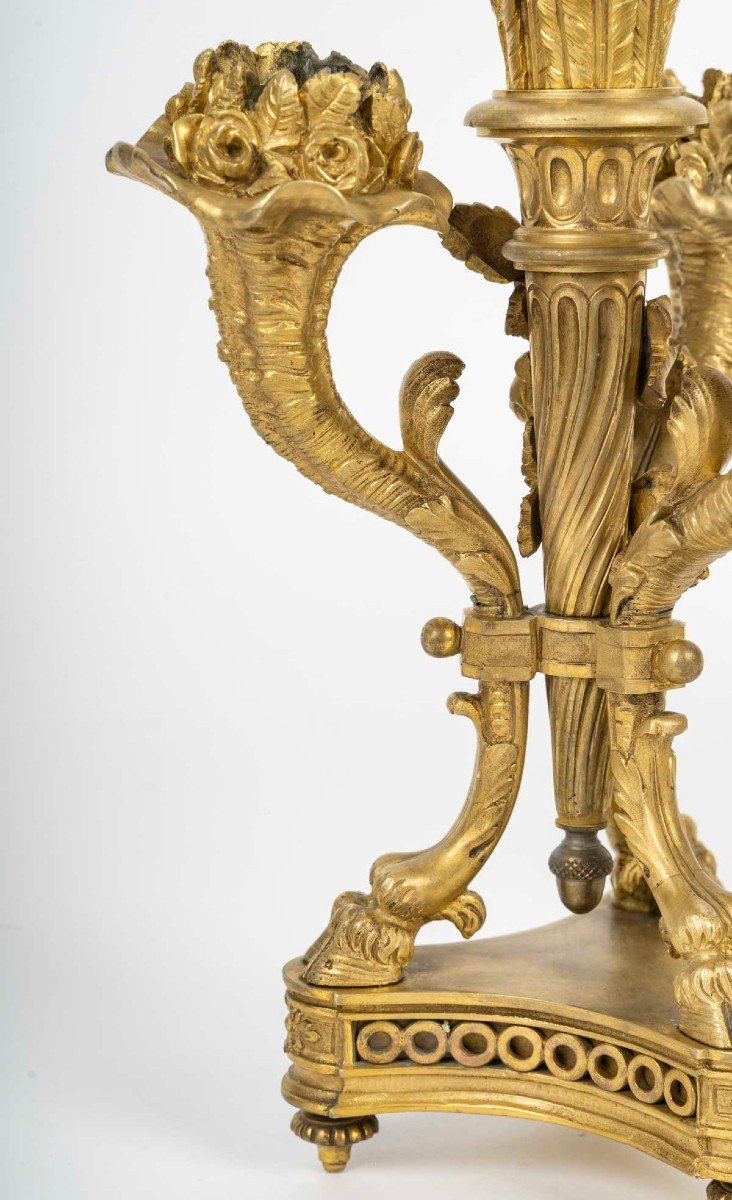


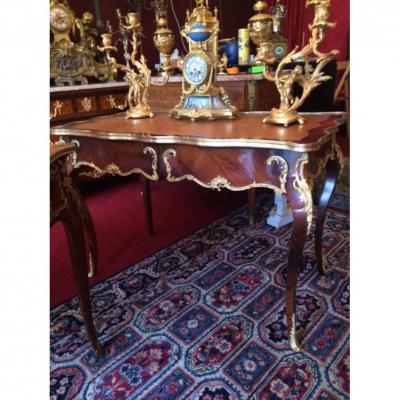
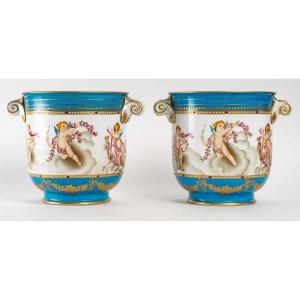


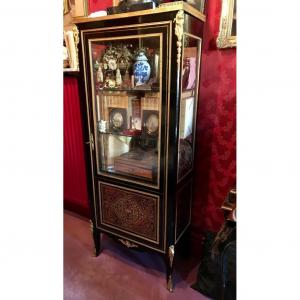
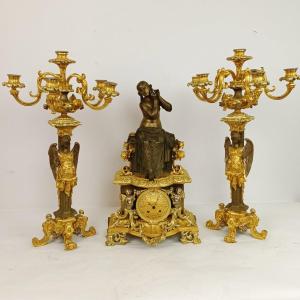

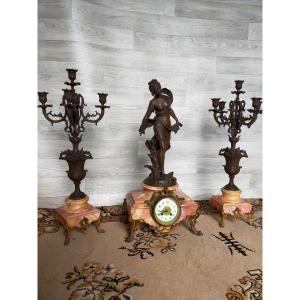
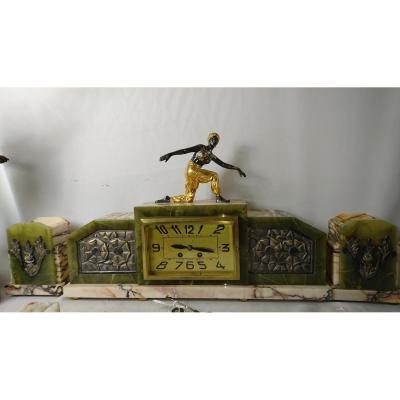
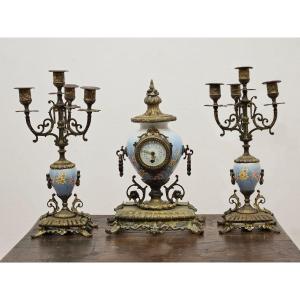
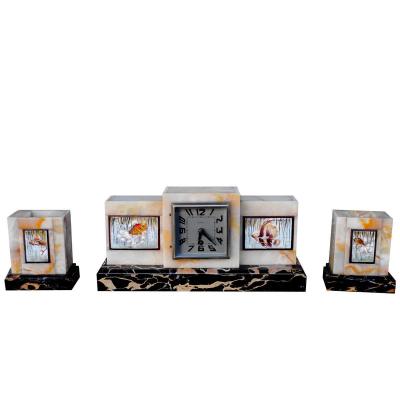



 Le Magazine de PROANTIC
Le Magazine de PROANTIC TRÉSORS Magazine
TRÉSORS Magazine Rivista Artiquariato
Rivista Artiquariato
